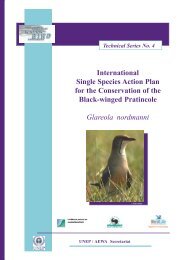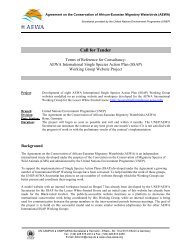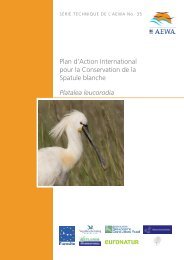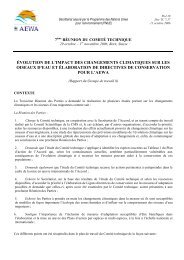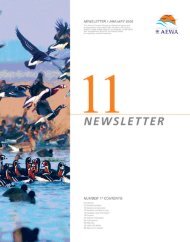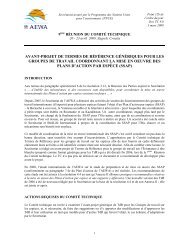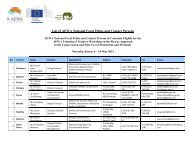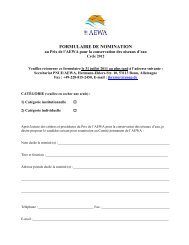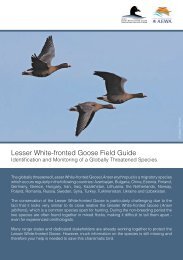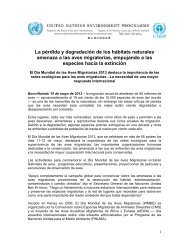International Single Species Action Plan for the ... - AEWA
International Single Species Action Plan for the ... - AEWA
International Single Species Action Plan for the ... - AEWA
Create successful ePaper yourself
Turn your PDF publications into a flip-book with our unique Google optimized e-Paper software.
<strong>AEWA</strong> Technical Series No. 36<br />
The completion of a fully comprehensive threat assessment is limited by <strong>the</strong> fact that<br />
knowledge of <strong>the</strong> species’ numbers, distribution and movements is still far from complete.<br />
Fur<strong>the</strong>r details of each of <strong>the</strong>se issues are provided below.<br />
(a) Threat factors causing high mortality of fully grown birds 5<br />
Hunting<br />
Breeding grounds<br />
Importance: Medium<br />
Illegal spring hunting occurs in many areas of <strong>the</strong> Russian breeding grounds. Illegal roundups<br />
of moulting birds also occur in Russia.<br />
In one of <strong>the</strong> municipalities where breeding occurs in Norway, spring hunting of ducks is<br />
legal. However, both geese (probably including some Lesser White-fronts) and swans are also<br />
shot during this period, albeit illegally. Spring hunting <strong>the</strong>re<strong>for</strong>e poses an additional threat to<br />
<strong>the</strong> Fennoscandian population and should be stopped (T. Aarvak, pers. comm.).<br />
Staging/wintering grounds<br />
Importance: Critical<br />
Hunting has a critical impact on <strong>the</strong> species as whole; it is thought that more than 95% of <strong>the</strong><br />
global population is affected by over-hunting (UNEP/WCMC, 2003). Within <strong>the</strong> <strong>AEWA</strong> area,<br />
hunting pressure is extremely high in both <strong>the</strong> Russian Federation and Kazakhstan. Overhunting<br />
in China is also a key threat to <strong>the</strong> East Asian population (UNEP/WCMC, 2003).<br />
Hunting pressure arises from several sources, including subsistence hunters and sport hunters.<br />
The latter category also involves ‘hunting tourism’ whereby hunters (generally from richer<br />
western countries) pay to hunt desirable quarry species, often in eastern countries where<br />
hunting controls may be poorly en<strong>for</strong>ced. It should be underlined that Lesser White-fronted<br />
Goose is officially protected by hunting legislation throughout virtually its entire range.<br />
Illegal hunting (whe<strong>the</strong>r subsistence or sport) is <strong>the</strong>re<strong>for</strong>e <strong>the</strong> key issue. In many cases, it must<br />
however be assumed that accidental shooting is also a reason <strong>for</strong> high mortality, when hunters<br />
mix up Lesser Whitefronts with <strong>the</strong> very similar ‘look alike’ species Greater White-fronted<br />
Goose Anser albifrons, an important legal quarry species (when birds are in flight it is even<br />
difficult <strong>for</strong> experienced ornithologists to separate <strong>the</strong> species). Additionally it should be<br />
noted that spring hunting of geese and waterfowl is still a legal and widely practiced in Russia<br />
and o<strong>the</strong>r ex-Soviet countries. There are high levels of ignorance and/or disregard of <strong>the</strong><br />
applicable hunting laws more broadly.<br />
High hunting pressure has been observed at many locations in Russia and Kazakhstan. The<br />
loss in Kazakhstan of birds fitted with satellite transmitters and rings has supported <strong>the</strong><br />
anecdotal evidence that hunting pressure is especially high here (UNEP/WCMC, 2004).<br />
Indirect pressure as a result of hunting includes disturbance caused by hunting <strong>for</strong> o<strong>the</strong>r<br />
species and may lead to loss of condition, <strong>the</strong>reby contributing to adult mortality. This type of<br />
disturbance has occurred, <strong>for</strong> example, at traditional autumn staging areas in Finland<br />
(UNEP/WCMC, 2004) even though <strong>the</strong> Lesser White-fronted Goose itself is strictly protected<br />
under <strong>the</strong> Finnish Nature Conservation Act. Heavy hunting pressure is common in <strong>the</strong> coastal<br />
wetlands along <strong>the</strong> western shore of <strong>the</strong> Black Sea where Lesser White-fronted Geese winter.<br />
In December 2007, an adult Lesser White-front, colour-ringed in Norway, was found shot<br />
inside <strong>the</strong> Lake Kerkini Wildlife Refuge in Greece (www.piskulka.net).<br />
There are indications that Lesser White-fronts are being accidentally shot by goose hunters at<br />
Porsangen Fjord in Norway during <strong>the</strong> birds’ autumn staging period. A. albifrons does not<br />
5<br />
While this section focuses on <strong>the</strong> <strong>AEWA</strong> Agreement Area, key threats to <strong>the</strong> Eastern main population are<br />
mentioned briefly to provide an appropriate global context <strong>for</strong> <strong>the</strong> species as a whole.<br />
<strong>International</strong> <strong>Single</strong> <strong>Species</strong> <strong>Action</strong> <strong>Plan</strong> <strong>for</strong> <strong>the</strong> Conservation of <strong>the</strong> Lesser White-fronted Goose 29



